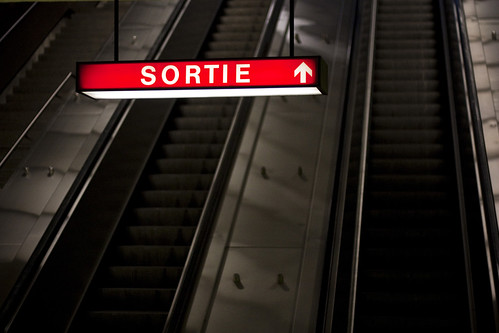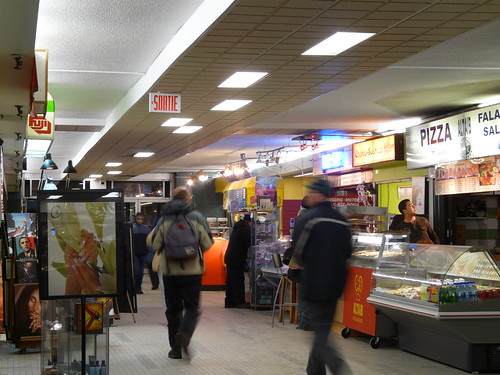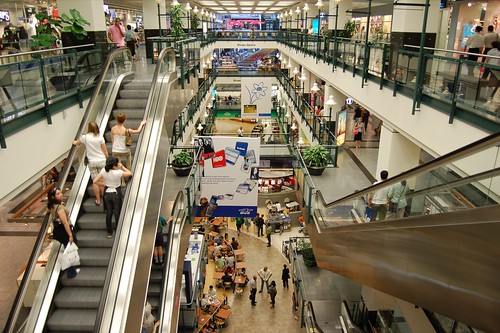Montreal's Underground City
If you live in Montreal, you’ll eventually be asked the question: “Which way is the underground city?” You will probably be walking along Ste. Catherine Street, the city’s main shopping artery, where H&M and Zara jostle for space with strip clubs and hot dog joints. Or maybe you will be making your way through the lunch-hour crowds at McGill metro, the city’s busiest subway station. Either way, some puzzled visitors clutching a free tourist map will ask you a question that you will find particularly difficult to answer. The best you can do is to point them to the entrance of the nearest shopping mall or metro station and explain, “It’s there, but it might not be what you imagine.”
One of the first things any tourist guide to Montreal tells you is that the city is home to a 32-kilometre network of shopping malls, office buildings, apartment towers, cultural centres, universities and civic institutions connected by subway lines and a sinuous network of underground passageways. On those brutal winter days when the thermostat plunges below -20 degrees Celsius, you can go to work, watch a movie, buy a baguette, attend a concert, go skating, visit the library and finally return home, all without venturing outdoors. Somehow, though, the underground city has taken on levels of meaning outside Montreal that it never quite achieved at home. Tourists seem to picture a Willy Wonka wonderland of enterprising Oompa Loompas untouched by the light of day. Locals are nonplussed. For them, it’s a way to get from one place to another. When the journalist Fabien Deglise wrote a book about the underground city, he called it Montréal souterrain, sous le béton, le mythe. Underground Montreal: the Myth Beneath the Concrete.
Make no mistake, however: the underground city is more than the sum of its parts. For one thing, “underground city” is a bit of a misnomer, since many parts of the network exist above ground. It’s really an indoor city, a kind of interconnected, three-dimensional space. “Underground Montreal is an amalgam of grey tunnels and bright avenues, of escalators and indoor squares populated by fast food and shops of all types,” writes design critic Emmanuelle Vieira. “This city in successive layers is incoherent, imperfect, but it holds its own. It is the image of own own society: lively, diverse and creative, linked intimately with the culture of consumption.” It also the unlikely triumph of modernist ideals that long ago fell by the architectural wayside, only to now be reconsidered and—in some cases—rehabilitated.
Photo by Martin Provost
Compared to most North American cities, Montreal is densely populated, and its downtown core is especially compact. In a 3.5-kilometre strip of land between the slope of Mount Royal and the waters of the St. Lawrence, there are hundreds of office and apartment towers, thousands of shops, three large universities and countless other commercial, cultural and institutional activities. The underground city lurks beneath it all, split into several distinct sections and connected by two parallel metro lines. In the west, Atwater metro is attached to a cluster of shopping malls, apartment towers, offices and a college. In the east, Berri-UQAM station anchors a network that includes the city’s main library, an intercity bus station, a major commercial centre and the Université du Québec à Montréal, where 35,000 students reach their classes through underground passageways. In between these outliers is the main bulk of the network, incorporating six metro stations, the city’s main train station, eight major shopping malls, a hockey arena, convention centres, government offices, theatres, concert halls, hotels and too many coffee shops and shawarma stands to count. The network continues to grow: an expansion will soon take in a major new hospital and research complex.
The underground city’s expansion has been haphazard, but its inception was entirely deliberate. In the late 1950s, architect I.M. Pei and his partner, Henry Cobb, were hired to design Place Ville-Marie, a large office complex uphill from Montreal’s main office district. Place Ville-Marie’s austere design, cruciform shape and large public plaza were self-conscious attempts at creating the gravitas required of a new landmark for an ambitious city. The project was revolutionary. Not only did it create a new centre of economic gravity in Montreal, it buried half of its 280,000 square metres of floor space underground. This particular idea came from Vincent Ponte, the urban planner who drafted the project’s master plan. Ponte was captivated by the ideas of the Futurist movement, and in particular the Italian architect Antonio Sant’Elia’s 1914 plans for a machine-like Città Nuova in Rome. Place Ville-Marie was a chance for Ponte to put his vision for “the multi-level, interconnected city” into practice.
Place Ville Marie’s construction in 1960. Photo from the Archives de la Ville de Montréal
In her essay Notes from the Underground, historian Rosalind Williams notes that since the start of the Industrial Revolution, technological development has led humans to push ever deeper underground — the first railroad was developed to make iron mining more efficient, for example. Meanwhile, early 20th century modernists began to conceive of the city as machine: a network of systems that could be made rational and more productive. As Montreal grew both outwards and skywards, it seemed only natural to push underground, too. After Place Ville-Marie was completed in 1962, Ponte began working on plans for an underground network linking another big complex, Place Bonaventure, with Place Ville-Marie and Montreal’s new metro system. He even dreamed of a giant underground plaza just north of Place Ville-Marie.
The 1960s were transformative years in Quebec. After decades of corrupt rule by strongman Maurice Duplessis, who ran the province with the help of a small business elite and the Catholic Church—a period known as the Grande Noirceur, or Great Darkness—the province entered a determinedly progressive phase called the Quiet Revolution. Companies were nationalized, universities established, the Catholic power structure overturned and French-language nationalism promoted.
All of this social, political and economic upheaval were accompanied by a revolution of the physical sort. “Montreal wanted to open the doors to the immediate future with the keys given to it by the middle of the century — consumerism, performance, cleanliness and grandeur,” Fabien Deglise said after Montréal souterrain was published in 2009. New highways swept through the city; new islands were created in the St. Lawrence; old neighbourhoods were cleared for office and apartment towers. 1967 was a high note, the year of the World’s Fair, when Montreal earned its lapels as a real metropolis. “Flying into Montreal, coming from dowdy London, via decaying New York, I was instantly struck by the city’s affluence,” noted the author Mordecai Richler when he returned to the hometown he had fled in the early 1950s.
I rode into the city on multi-decked highways, which swooped here, soared there, unwinding into a pot of prosperity, a downtown of high-rise apartments and hotels, the latter seemingly so new they could have been uncreated the night before. Place Ville-Marie. The metro. Expo. Ile Notre-Dame. Habitat. Place des Arts. This cornucopia certainly wasn’t the city I had grown up in and quit.
One of the era’s ironies was that so much of that change was the doing of one powerful man, Mayor Jean Drapeau. He was famously earnest, uncorrupt and grandiose in his vision for Montreal, but he was also uncompromising, authoritarian and happy to break a few eggs to make an omelette. Vincent Ponte shared some of the same characteristics. “All the great cities of the world were created by kings and emperors who had taste,” he told the Montreal Gazette, pointing to the reshaping of Paris by Baron Haussmann. “He rooted people out of their homes, with no compensation to do it. Not democratic at all.” The implication, intended or not: democracy is an obstacle to development.
Whereas Drapeau was dour and humourless, however, Ponte had charisma. “His sleek elegance combined with a certain sinister air, generated by the dark glasses he invariably wears, suggests that he is either a smooth playboy or a rather chilling mafioso,” wrote a columnist for the Montreal Star. Buoyed by the success of Montreal’s burgeoning underground city, Ponte travelled around the world as a consultant, selling his vision for grade-separated pedestrian networks. One of his most fateful stops was in Dallas, where he proposed an system of tunnels and footbridges connecting office buildings in the downtown core. “Vincent Ponte was very powerful and very persuasive,” recalls Dallas real estate broker Jack Gosnell. When Ponte pitched his idea to local politicians, planners and developers, they bought in enthusiastically, laying the groundwork for the 36-block Dallas Pedestrian Network.
Similar underground cities exist throughout the world, from Toronto to Osaka. But none match the scale of Montreal’s, and none have achieved quite the same mythical status. Part of the reason is that Montreal’s underground city is nearly as heterogeneous as the city above. Despite being underpinned by modernist theory, and despite Ponte’s attempts to create a centrally-planned network, the underground city developed in a piecemeal fashion over a period of 50 years.
“We consider the underground city part of the city above, and that’s why we don’t have a specific plan for the underground,” says Jacques Besner, a Montreal urban planner. In the 1980s and 90s, Besner worked for Montreal’s city government, arranging for property developers to link their projects to the underground city. This usually involved leasing space underneath streets so that a developer could build a tunnel linking his development to adjacent buildings. “If you take a scale model of downtown and push it into the ground one or two stories, and link all the basements together, that’s what we have,” says Besner. In exchange for the right to connect a building directly to a metro station or some other public amenity, property owners must keep their underground passages open to the public until the metro closes at 1am. It’s a key distinction between Montreal’s underground city and those of most other cities, where access is controlled unilaterally by property owners.
Besner tells me that most Montrealers don’t realize how big the underground city really is. “They take the subway from near their home, go to downtown to shop or work and they go back,” he says. But exploring the underground city can be surprisingly rewarding. Transitions are abrupt, leading to unexpected juxtapositions. When you enter Peel metro from Stanley Street, you find yourself in a grimy corridor filled with Arab pop music and the scent of spices. Pass through the metro station, with its eccentric art installations and stuffy art, and you will soon step into Les Cours Mont-Royal, a posh mall carved out of the hulking body of a 1920s-era hotel. All around you are the faces and voices of Montreal: teenagers and businesspeople, university students rushing to class, the occasional homeless man sitting forlornly on a bench. French and English blend together, mixing occasionally with Spanish, Arabic and Mandarin.
Corridor near Peel metro. Photo by urb_mtl
Eaton Centre. Photo by Lorhkan
Complexe Desjardins. Photo by damali101
Everyone has their own favourite part of the underground city. I’m partial to Central Station. Built in 1943 and designed by John Campbell Merrett, the Canadian National Railway’s in-house architect, it is a ground-level structure that exists almost entirely within the context of the underground city. It took me years to realize that the station is not, in fact, underground. Approaching it from the street is a puzzling task, since it is surrounded on all four sides by office towers; its factory-like appearance doesn’t make matters any easier. From the underground, though, you can wander down from Place Ville-Marie, past coffee shops and bakeries, emerging into the hushed space of the station concourse, which is lined by art deco friezes that depict the men and women of Canada working with socialist fervour.
The Université du Québec à Montréal is another interesting spot. Built in the mid-1960s, it is a full-fledged part of the underground city, with student life taking place below the streets. “Being in the ivory tower of the underground city is so different from being in the business district or the shopping district,” says Alanah Heffez, editor of Spacing Montreal, an urban issues blog. “It has much more of a hive feel. Rather than chain stores, there are student-run co-ops. The walls are covered with bulletin boards, the halls are abuzz with students and the whole place hums with an undercurrent of revolution.” In one particularly charming part of campus, the corridors give way to a large atrium built inside the interior of a 150-year-old greystone church.
A similarly grand space can be found within the Complexe Desjardins, a hotel, office and shopping complex. When it opened in 1976, it was a radical departure from the other malls and office towers that formed the underground city, because it includes an enormous sunken atrium that plays host to more than 200 exhibitions and events per year. “People can sit there and enjoy looking at other people,” says Jacques Besner. In the 1980s and 90s, other developments followed suit, with large atria that allowed natural light to penetrate even to the lowest basement level. The underground city was made friendlier is other ways, too. In 2004, the system was rebranded as RÉSO (a stylized version of réseau, meaning network), with new maps and wayfinding signs. All of this ensures the underground city’s immense popularity. Every day, one out of seven Montrealers—more than 500,000 people—pass through some part of the system.
That stands in sharp contrast to Vincent Ponte’s other underground city. Not long after the Dallas Area Network was established, downtown fell into steep decline, and department stores and other retail shops moved to the suburbs. Critics accused the tunnels of sucking people off the street, which killed their ambiance and led people to abandon downtown as a shopping destination. One former mayor decried the underground network as “the worst urban planning decision that Dallas ever made” and said, “In a perfect world, the tunnels would be gone.” These days, some parts of the underground city are closed, and the rest is treated by Dallasites as a novelty. Jack Gosnell likens it to “a family with an eccentric cousin living in the basement.”
In the 1990s, it became fashionable to blame grade-separated pedestrian networks for killing streetlife and accelerating urban decay. But that oversimplifies the situation. Most of the reasons why downtown Dallas declined had nothing to do with the tunnels. For one thing, Dallas is a low-density, car-oriented city, and the flight of retail shops and offices from downtown to suburban areas followed a pattern set by dozens of other American cities. By contrast, Montreal’s underground city is interwoven with a heavily-used metro system, and downtown Montreal is far more diverse and densely-built than Dallas ever was, with universities, offices, shops and a strong residential population located in the same small area. Rather than competing with the streets, the underground city complements them. A study by researchers from the Université de Montréal compared streetside clothing stories with those in the underground city and found little evidence that one group hurts the other.
Far from a modernist folly, the underground city has come to represent a new form of urbanity. In Cities Without Ground, a book published earlier this year, architects Jonathan Solomon, Clara Wong and Adam Frampton make the argument that “public space does not require stable ground.” In studying Hong Kong’s interconnected networks of subway stations, shopping malls, offices and elevated public spaces, the trio have developed a model of a new kind of urbanism in which public activity occurs on multiple planes. Public and private space are blurred, and civic life exists above, below and beyond the ground level with which it is normally associated.
This idea can even be taken to extremes. As I write this, Montreal has been rocked by four months of protests; they started as a student movement against tuition hikes, but they now seem to have morphed into something much larger. “The strike is for students but the fight is for everyone,” read one revolutionary banner strung from an apartment balcony. Most of these protests have taken place on the street, sometimes turning into riots, especially after the gatherings are declared illegal by police, who then attack protesters with tear gas and batons. But protests have also taken place inside the metro, library and shopping malls. And with participants arrested whether indoors or on the street, the distinction between the two realms seems especially vague. The streets have been privatized and the indoors made public. Maybe the reason it’s hard to tell tourists where to find the underground city is because it’s simply the city after all.
This essay was originally written for the World Architecture Review, a Chinese architecture journal, where it appears in translation.
From Urban Photo. Follow DeWolf on Twitter.
Subscribe to Maisonneuve today.
Related on maisonneuve.org:
—Drawn and Quartered
—Another Montreal: Special Tours for the Indifferent Traveller
—Montreal's Navarino Cafe: A Love Letter











